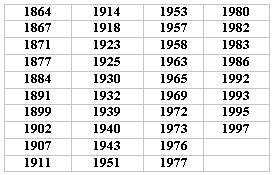El Niño - (n.)
(Pronounced “El Nin-yo”) The term refers to the “Christ Child” and originates with the fishermen in Ecuador and Peru who apply it to a warm current that appears every few years in their fishing areas around Christmas. Normally, the cold Peru Current (or Humboldt Current) flows offshore from south to north. Associated with the cold current is a process called "coastal upwelling,” the rising of cold subsurface water. This water is rich in nutrients, nitrate and phosphate. The nutrients stimulate the growth of microscopic green algae, called phytoplankton, that produces food for zooplankton and fish. Whenever the warm current appears, upwelling ceases and phytoplankton production is greatly diminished. This happens every three or four years or so, in December (hence the term “Christ Child”) but not on a predictable schedule. The appearance of the warm current off Peru is a spill-over from a much larger event: a general warming in the eastern tropical Pacific during certain years. Normally, the Pacific trade winds move warm tropical surface waters to the west, piling it up in the "warm pool" region between Indonesia, the Philippines and New Guinea. The water there has a year-round temperature close to 29°C (85°F). For some reason, during certain years, the trade-winds weaken and warm surface water is no longer carried westward. On the contrary, during El Niño the piled-up warm-pool water starts moving east, taking the convection region with it, and the tropical rain that is associated with warm surface waters. The surface waters in the eastern region become warm. Now suddenly tropical storms occur in the region of Tahiti,and the coral there suffer from being too warm, shedding their color-giving algal symbionts. In contrast, drought strikes in the western areas, which are no longer in the convection center (e.g. New Guinea, Indonesia). Extraordinary events of precipitation in southern California (which produce high stream flow or flooding) are commonly associated with El Niño conditions, when the eastern Pacific is unusually warm. Winter storms, generated in the North Pacific, move farther south than at "normal" times and have the opportunity to pick up moist tropical air along the way. Absent an offshore high which acts as a barracade, the storm systems can invade the region and dump their load. The question is why El Niño events occur at all, and why they come at intervals of typically three or four years. The answer is not known, but apparently, the buildup of the western warm pool by the trade winds sets up an unstable situation. Once decay of the pool is triggered, the process feeds on itself since the redistribution of warm water interferes with normal trade wind patterns. It then takes well over a year to get things back to "normal."
How will global warming change affect the occurrence of El Niño events? Using variations in several indicators (air pressure, temperature, cloud, etc.), climatologists observe a tendency toward more frequent occurrence in El Niño conditions, for the last twenty years. Also, there are fewer "colder-than-normal" conditions, with especially strong trade winds and a corresponding warm pool pile-up. It is not clear, at this point, whether this change is permanent and whether mankind's activities have anything to do with it. Conceivably, the ongoing addition of greenhouse gases to the atmosphere is making conditions more favorable for the development of El Niño conditions. Alternatively, the climate system will eventually return to a previous state of fewer and less pronounced El Niño events, and their recent greater abundance is simply part of long-term climate cycles. Research on laminated sediments in Santa Barbara Basin, which contain a record of floods in the drainage region of Santa Barbara, suggests that such long-term cycles exist. One prominent cycle lasts a hundred years or so, another about fifty years. The answers will come from a more detailed study of the historical record, and from improved models of climate, which will including the strange anomalies called El Niño. See the table below for a list of the El Niño years in San Deigo since 1950.
Table of years of El Niño conditions in San Diego County (From 1950 onward, these years had strong rains in December):

